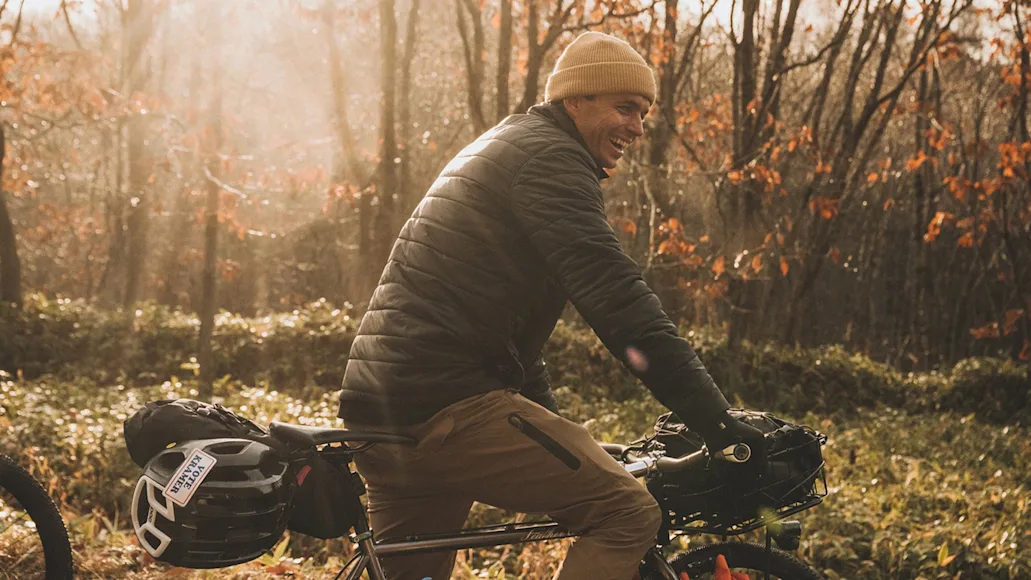_We may earn revenue from the products available on this page and participate in affiliate programs. Learn more ›
_
Best Overall

Rab Men’s Xenair Alpine Insulated Jacket
Warmest
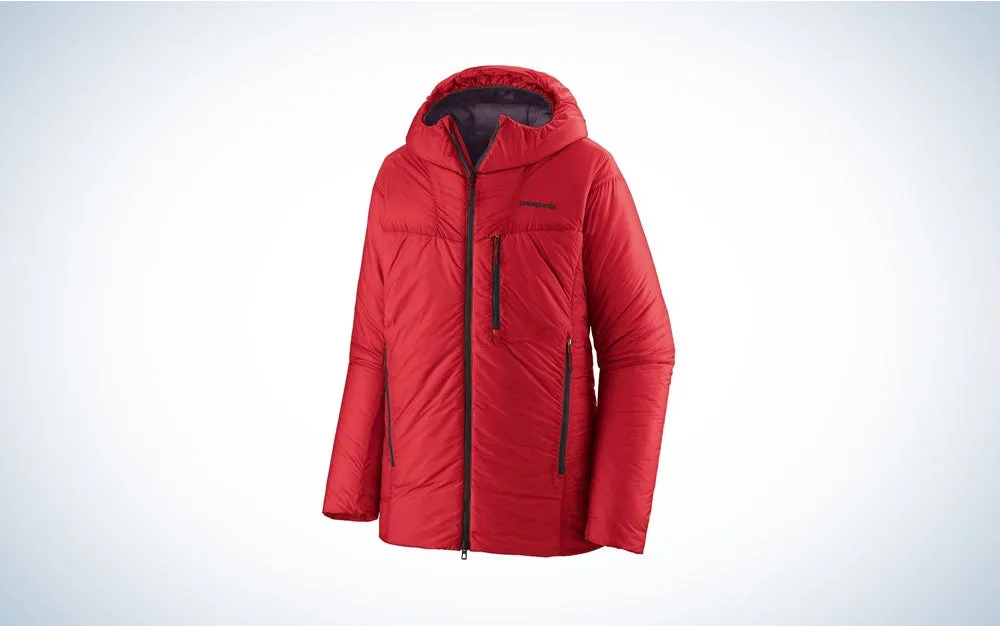
Patagonia DAS Parka
Best Budget
Decathlon Forclaz Men’s Synthetic Backpacking Jacket
Nothing is more miserable than being cold outside. That’s why there are whole categories of gear designed to keep you warm. But a good synthetically insulated jacket might just be the best piece of equipment to have in cold weather. More performance-oriented (and often less expensive) than down, synthetically insulated jackets work by trapping pockets of warm air and insulating the body. They insulate even when wet, and the factory-engineered construction allows brands to customize the insulation properties. Technology companies like Primaloft have created futuristic insulation that sheds heat while in motion and retains it while at rest, like climate control for your outdoor adventures.
There’s a wide range of jackets out there, each with its own specific strengths and usage occasions. We rounded up the best available and put them head-to-head. With luck, it will save you from sharing the same fate as Jack London’s protagonist in “To Build a Fire,” though it’s always a good idea to brush up on your campfire building skills
as a backup. Here are the best synthetic insulated jackets you can buy.
Best Overall: Rab Men’s Xenair Alpine Insulated Jacket
Best for Changing Conditions: Sitka Ambient Jacket
Best Active Insulation: Black Diamond First Light Hybrid Hoody
Warmest: Patagonia DAS Parka
Best for Watersports: Orvis PRO HD Insulated Hoodie
Best Shirt Jacket: Roark Chopper Jacket
Best Parka: Fjallraven Nuuk Lite Parka
Best Budget: Decathlon Forclaz Men’s Synthetic Backpacking Jacket
How We Tested the Best Insulated Jackets
The outdoor industry, while still burgeoning, has proliferated into hundreds of brands, many offering their take on synthetic insulation. We pulled from companies with legacies in the outdoor space and from newcomers offering innovative tech. Then, we separated our picks for pursuit-specific activities like hunting, fishing, climbing, and camping to determine which jackets would make the testing rounds.
Using past adventures as a touchpoint, we tested these jackets on a series of outdoor pursuits: ice climbing frozen waterfalls, snowshoeing frozen trails, blustery pre-dawn canoe rides, alpine ski turns, and rugged Canadian forest roads. The final selection of jackets distinguished themselves from their peers in performance, price, and features. Each jacket on this list offers something different than its competitors, whether that is technology, value for cost, or features for a specific activity. Sure, there are a lot of good jackets out there, but for our money, these are the best you can buy.
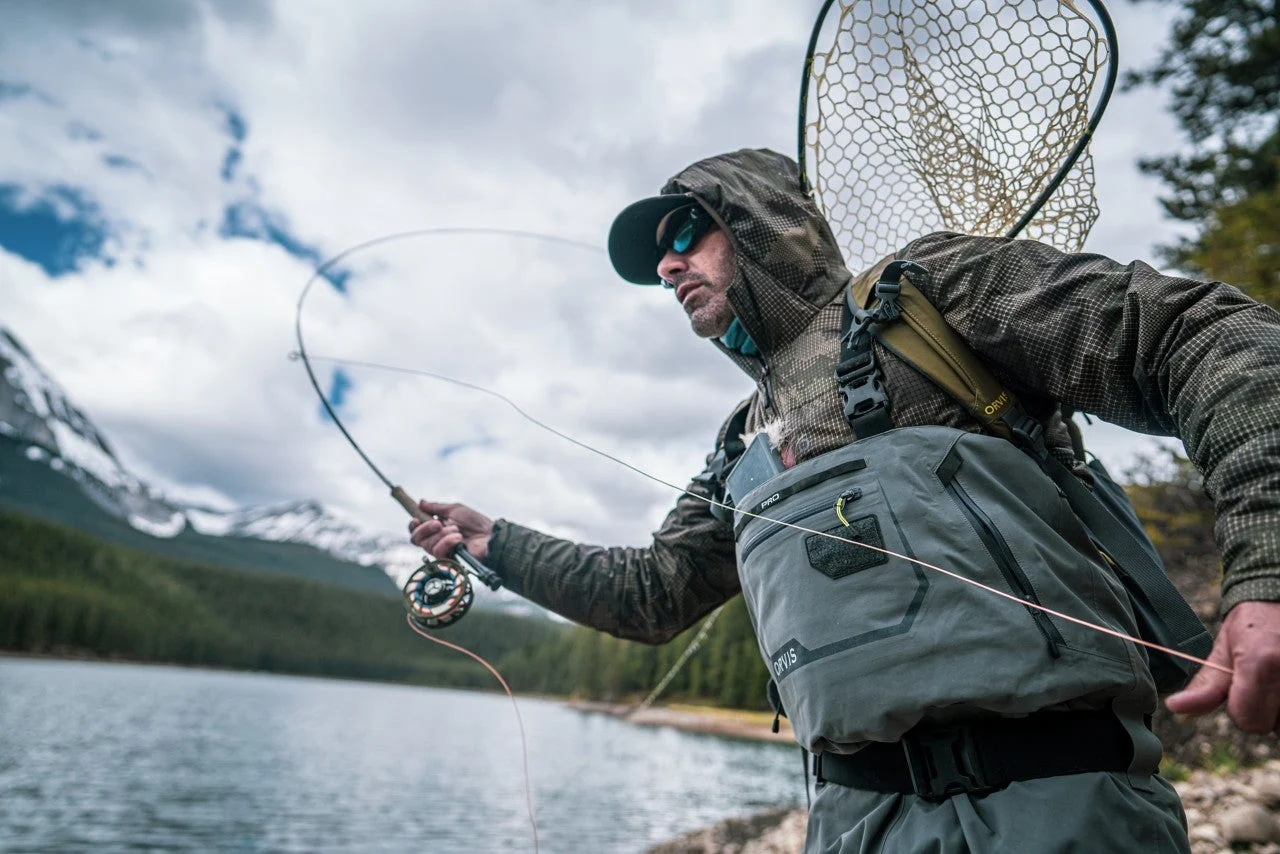
A good insulated jacket is crucial for fall and winter fishing. Orvis
Best Insulated Jackets: Reviews and Recommendations
Best Overall: Rab Men’s Xenair Alpine Insulated Jacket

Specs
Main Fabric: 20D Pertex Quantum Air with fluorocarbon-free DWR
Fabric Lining: 20D Recycled Nylon
**Insulation:**133 gsm PrimaLoft Gold Insulation Active+ (55 percent recycled content) through the front, back sides, outer arms, and hood
Weight: 553g/19.5oz (Size M)
Pros
Excellent cost-to-feature ratio
Four-way stretch face fabric makes the jacket extremely mobile
Four exterior pockets
Cons
No interior pockets
Slightly oversized fit
I first picked up an earlier version of Rab’s Xenair jacket for an ice-climbing trip to Michigan’s Upper Peninsula, where the abundant waterfalls freeze every winter and create a Midwestern haven for the traditional alpine sport. Since then, I’ve put the Xenair through the proverbial and literal paces. High desert nights in Moab, ski tips in the Rockies, and repairing Grand Canyon bound gear in an unheated warehouse. My Rab has seen plenty of action and it has never let me down.
While I’m not ready to part with my original jacket for sentimental reasons, the 2023 version of the Xenair makes a compelling case to do so. Head to head, the Xenair has the most performance features for the best value, making it our pick for the best overall synthetic insulated jacket. It boasts four external pockets, a drop tail hem, and Primaloft’s Active insulation. A subtle 4-way stretch helps the jacket move with you, and the two-way YKK front zipper lets you adjust the temperature on the fly. At $260 dollars it’s not a budget pick, but it outperformed other jackets in the test, which cost almost double.
Best for Changing Conditions: Sitka Ambient Jacket
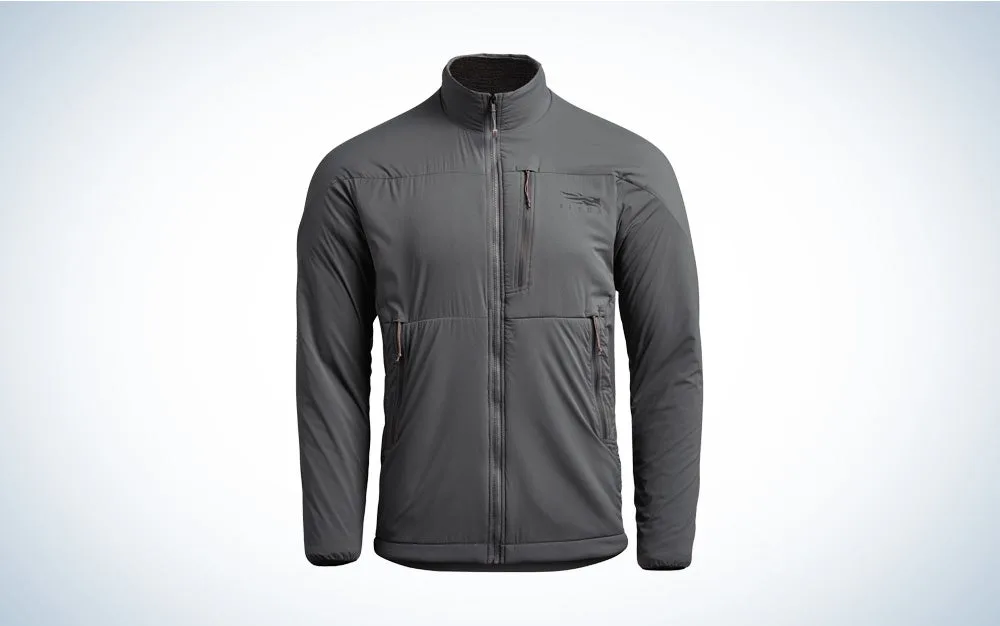
Specs
Fabric: 20D ripstop nylon
Insulation: 150 grams post-consumer recycled PrimaLoft Evolve active insulation for breathable low-bulk warmth
Weight: 18 oz
Pros
Adaptive insulation tech keeps you warm in variable conditions
Warm and comfortable fleece lining
Mechanical stretch for movement
Durable water-repellent finish
Zippered hand and chest pockets
Cons
Expensive
Sitka designed the Ambient Jacket series with PrimaLoft Active Evolve, a technology that’s designed to mimic animal fur. As in dumping heat while in motion, but retaining it while still using a combination of recycled polyester fibers made up of different deniers and lengths. And while we can’t realistically compare this jacket’s insulation to a mammalian winter coat, we can say that it packs a surprising amount of warmth into a small space. I tested the Ambient in the mountain bordered by Quebec’s Monts Valin’s National Park. I was well insulated despite the rain, sleet, and plunging temperatures. The jacket’s biomimicry tech kept me from sweating through my base layers while in heated UTVS on a two-track forest road but still toasty while paddling on alpine lakes. The Ambient Jacket also took home the best hunting jacket award in our annual Best of the Best gear round-up
in 2022. Senior Editor Ryan Chelius swears by the Ambient and carriers one for big game, waterfowl, and upland hunting adventures.
It is pricey for a jacket that technically acts as a mid-layer, but the technology delivers on its promises. For hunters, it easily slots into Sitka’s larger system of shells and hunting apparel. But non-hunters shouldn’t discount the tech just because it is marketed for hunters—it comes in solid colors and is extremely warm.
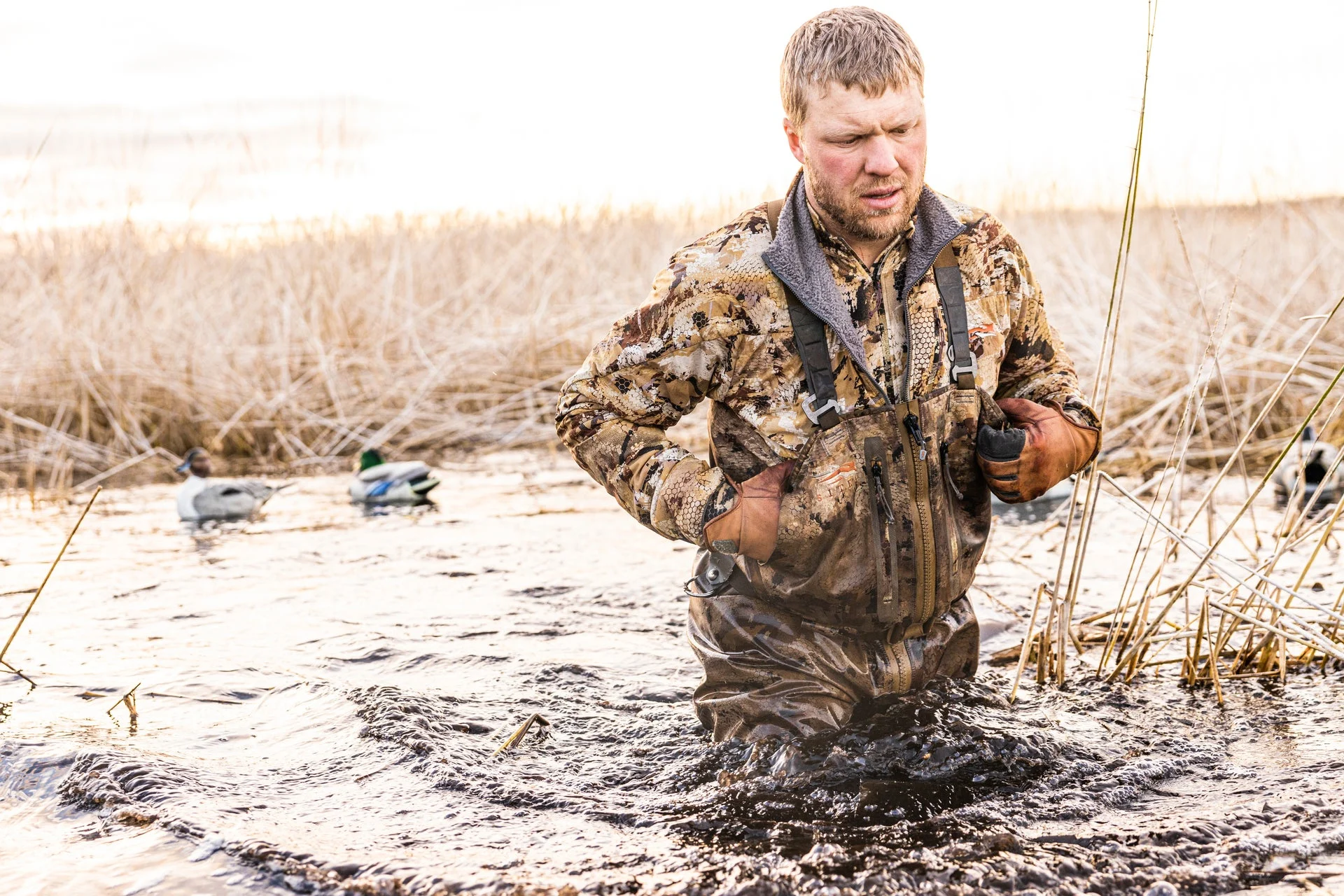
The Ambient Jacket is an excellent mid-layer during late season hunts. Sitka Gear
Best Active Insulation: Black Diamond First Light Hybrid Hoody
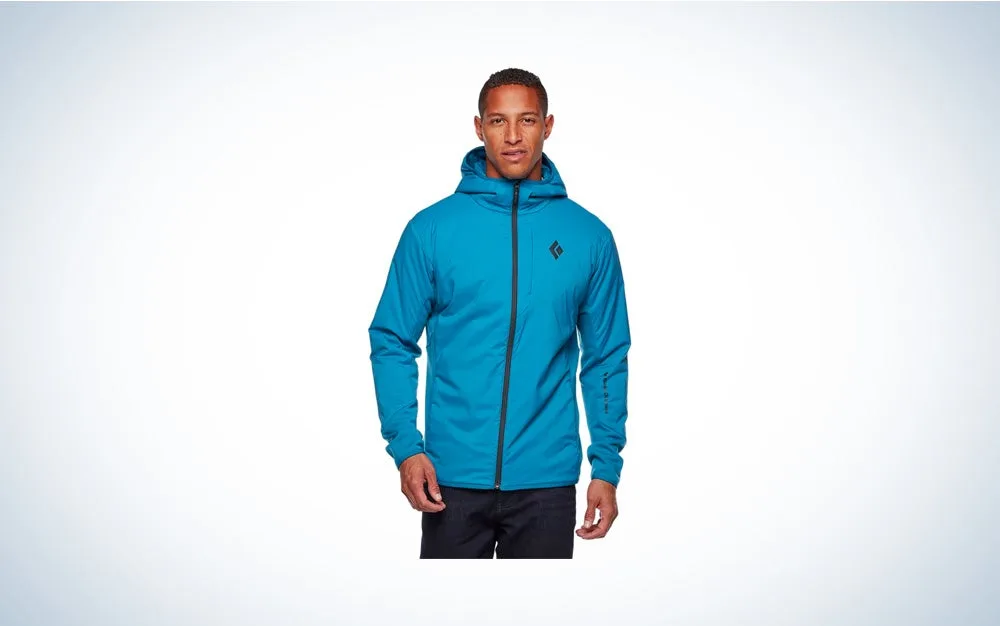
Specs
Insulation: Migration-resistant PrimaLoft Gold Active
Fabric: 20D stretch nylon ripstop shell with DWR coating
Weight: 0.361 kg / 12.73 oz
Pros
Merino wool panels for stretch and insulation
Non-migrating, active focused insulation in chest and arms
Helmet-compatible hood
Packs into chest pocket
Cons
Expensive
Won’t keep you as warm if you’re not moving
Black Diamond’s First Light Hybrid Hoody bills itself as a mid-layer, like a fleece that’s developed a bit of an insulation problem. And compared to other warmer jackets on this list, the First Light looks like a mid-layer on paper. But in practice, I found this was often the only jacket I needed for high-energy, cold-weather activities. Running, biking, or hiking in the cold is often a guessing game of starting out frigid but still feeling like you’re in a furnace once your heart rate gets to tempo. The First Light balances this by combining PrimaLoft Gold Active Insulation in the hood, chest, and arms with blended merino wool in the sleeve and back panel.
The result is a dynamic jacket with a wide range of motion for reaching handlebars or handholds in chilly weather. I found this jacket to be the Goldilocks of active insulation: warm enough not to shiver through the start of an activity, but technical enough to not sweat out as soon as my legs warm up. It also packs into its chest pocket, making it easy to stash as a quick layer for backpacking or hiking trips. A word of caution: this jacket performs best while in motion. Don’t plan on it as your only insulating layer for extended time outdoors, especially if you plan on standing still.
Warmest: Patagonia DAS Parka

Specs
Fabric: Ultralight recycled nylon ripstop face fabric with a water-resistant endurance coating
Insulation: PrimaLoft Gold Eco fused with aerogel technology—133-g insulation all over with an extra 40-g at the core places where additional warmth is needed most
Weight: 556 g (19.6 oz)
Pros
Extremely warm
Wind and weather-resistant face fabric
Two-way zipper helps harness access and heat control
Alpine helmet-compatible, single-point-adjustable hood with elasticized binding at hood opening
External left-chest pocket and handwarmer pockets
Cons
Bulky
Expensive
Disclaimer: you will feel (and look) like a marshmallow while wearing Patagonia’s DAS Parka. But when you’re toasty in a snowstorm, looks don’t matter. Patagonia’s belay jacket boasts PrimaLoft Gold insulation that the brand fused with aerogel technology to boost both warmth and softness. Patagonia also reinforced the core areas of this jacket with an additional 40 grams of insulation. This translates to unmatched warmth where and when you need it.
I’ve worn versions of this jacket for years, and I’ve yet to find another synthetic jacket that combines warmth and versatility like the DAS Parka. The 2023 version has small details that enhance an already great insulator. Like an internal elastic cuff that doubles as an optional thumb loop and a Pertex face fabric that cuts win and sheds snow and light rain. If you’re looking for a packable jacket, this is not it. Instead, we’d steer you toward the new Micro Puff Hoodie, which offers the best packability-to-warmth ratio of the range of jackets we tested.
Best for Watersports: Orvis PRO HD Insulated Hoodie
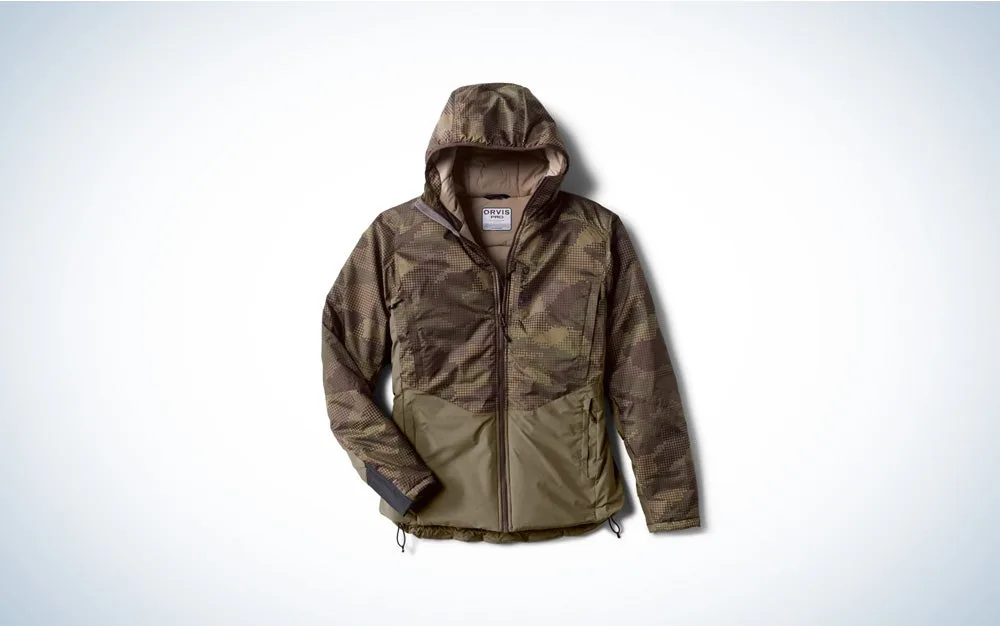
Specs
Fabric: 2L 20D mechanical polyester ripstop
Insulation: 170g of PrimaLoft Gold insulation across the chest and hood
Weight: N/A
Pros
Very warm
Excellent water resistance
Fleece lined pockets
Cons
Slightly oversized
Orvis’s PRO HD Insulated Hoodie is optimized for cold-weather water adventures. It’s packed with 170g of PrimaLoft Gold insulation, resulting in an exceptionally warm yet surprisingly lightweight feel. You can move in in this thing, whether you’re tying bowlines or casting flies. But the real standout detail is the face fabric. Made from a 2L 20D mechanical polyester ripstop, it’s windproof and exceptionally water resistant. It isn’t designed to hold off a torrential downpour, but it sheds snow, occasional rain showers, and paddles splashes with ease.
The arm and back panels are upgraded with a stretchy active version of Primaloft’s gold standard insulation. The two lower pockets are fleece-lined, and the cuffs are abrasion-resistant and have handy thumb loops to keep the jacket in place when layering a shell over it. It’s slightly oversized, which makes layering a waterproof shell or PFD overtop tricky. And It’s not cheap. But if you’re the type of person who decorates their house with tide charts and trout paintings, this jacket is made for you.
Best Shirt Jacket: Roark Chopper Jacket
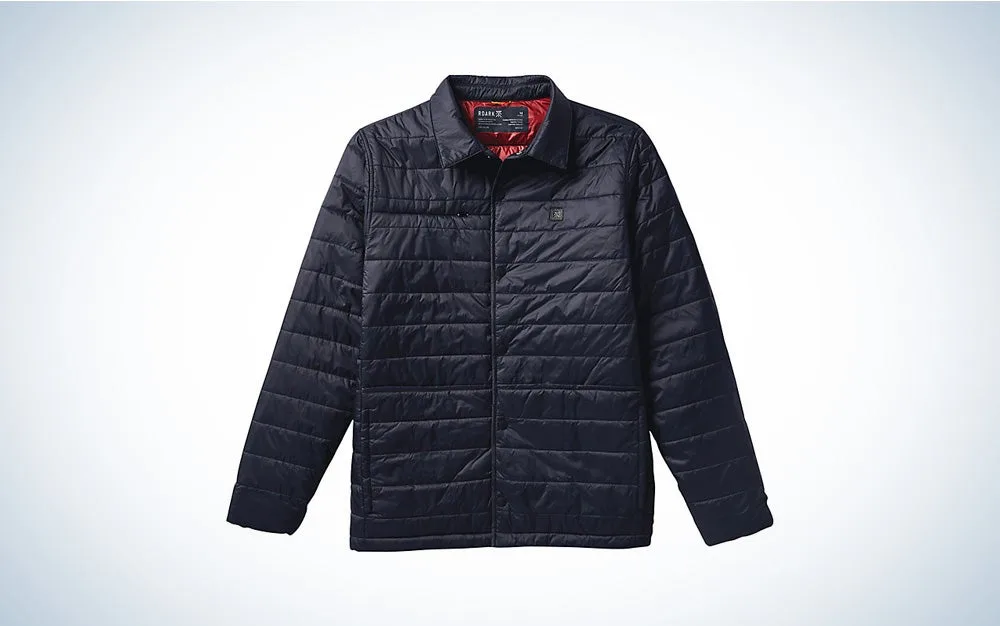
Specs
Fabric: Nylon micro ripstop
Insulation: Primaloft black 80gm
Weight: N/A
Pros
Magenic drop-in pockets are easy to use with cold hands/gloves
The baffled fit makes it easy to move
The collar is also insulated and can be flipped up for extra warmth
Includes stuff sack
Cons
Button instead of zip closure
An insulated shirt jacket is a modern version of those thick, scratchy wool overshirts your grandpa wore to split wood, tap maple trees, and general frontiersman style activities. Those rugged layers will always have their place, but modern tech allows for a more comfortable and better-insulated version of the classic outerwear piece. And even in good company, Roark’s Chopper Jacket is in a class of its own.
Don’t let the stylish cut fool you either. It is packable, built with a nylon micro ripstop, and insulated with recycled Primaloft. For these reasons, it’s become one of my go-to layers. It cut the cold on mountain bike trips to Quebec, and the women’s version fended off Northern England’s dreary cold on a recent overseas getaway with my wife. It’s full of small details, like magnetic drop-in-pockets, that are easy to use in colder weather. It’s certainly more of a midlayer (and a little more stylish) than the other jackets on this list, but its performance outshines more technical-looking mid-layers in spades.
Best Parka: Fjallraven Nuuk Lite Parka
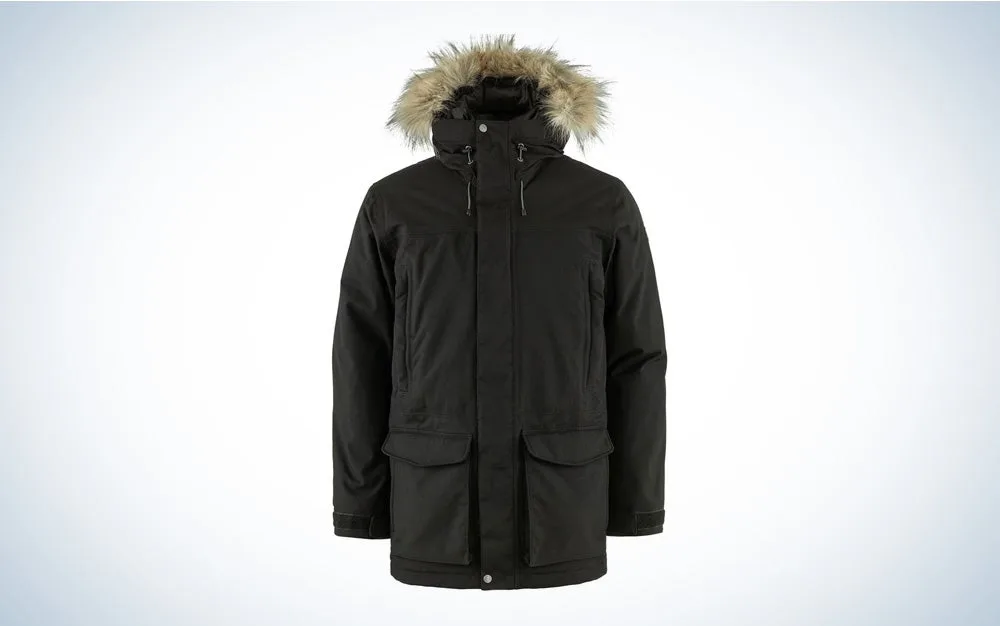
Specs
Waterproof Rating: 10000 mm
Insulation: 100g/m² synthetic insulation
Weight: 1470 g
Pros
Plethora of pockets
Knee-length fit optimizes warmth
The hood features a detachable synthetic fur and drawcord adjustment
Cons
Faux fur-lined hood can impede visibility
Face fabric performs better in snow than in heavy rain
Zipper can be tricky
Fjallraven’s Nuuk Lite Parka is new to the product lineup, complementing the already lauded regular Nuuk Parka. And while the regular Nuuk is unmatched for intense, arctic-cold scenarios, the Nuuk Lite is our pick for the best overall parka style. Unless you’re dog sledding on a glacier (Fjallraven is sending a team of first time dog sledders on an arctic adventure this winte
r), the Nuuk Lite balances warmth without overheating.
The jacket uses Supreme Microloft synthetic insulation, 90 percent of which is recycled. It falls to the mid-thigh, making it the longest jacket on this list, which is welcome on especially cold days when extra warmth is called for. The face fabric is 100 percent waterproof, meaning it’s ideal for long outings in bad weather. It is so warm and comfortable that it feels like a blanket. I used it on days when the snow was whipping, wore it during snow-blanketed hikes, and to scout blustery, late November freshwater surf breaks on Lake Michigan.
The faux fur hood, while adjustable, can limit visibility. The fur itself is removable, but it unclasps through a series of buttons that are hard to handle on the flue. And while the parka kept sleet out admirably, it isn’t my first choice for a layer in cold rain. While remaining waterproof, the parka tended to get heavy and cumbersome in a real downpour. But for winter expeditions where the main goal is to combine maximum coverage with a coat light enough to move in, the Nuuk Lite is unmatched.
Best Budget: Decathlon Forclaz Men’s Synthetic Backpacking Jacket
Specs
Fabric: 100 percent polyamide 39 g/sqm. 20 denier
Insulation: 125g synthetic fill
Weight: 370g
Pros
Entry level price
Retain warmth well
Jacket hem drawcord
Folds into its left-hand pocket using a zip with double double-puller
Surface-treated outer fabric to prevent water from getting in
Cons
Runs small, should size up for an accurate fit
The face fabric has low weather resistance
Despite its overseas pedigree, Decathlon is still a bit of a sleeper here in the States. Its business model hinges on providing gear for exceptionally low prices, while helping to reduce the financial barriers of entering into the outdoor world. The Forclaz synthetic jacket is an impressive combination of price and features. For $70, you get a lightweight, packable jacket with a weather-resistant face layer and recycled polyester fill. And while the brand claims that this jacket will keep you warm below freezing, I wouldn’t recommend it for any temps below 30 degrees. Although it does offer a fair amount of insulation for the price.
Paired with the correct base and mid-layers, the MT100 measures up to other lightweight, active jackets we tested. Because of its price point, I felt I could be less precious with it than some of the other big spenders here, making it my go-to campfire and open-fire cooking jacket. The jacket runs small, and it lacks the bells and whistles of the other jackets on this list, but it’s a solid dependable option for those looking to save a few bucks.
Things to Consider Before Buying a Synthetic Insulated Jacket
Each jacket on this list is the best-of-the-best for one reason or another. Some were chosen for specific pursuits, while others excel in specific conditions. But just because a particular jacket is warm and durable doesn’t necessarily mean it’s best for you. Determining activity, weather conditions, and desired fit will help narrow down a list of best overalls to the best for you.
Pursuit
Your activity will determine what features and insulation weight you need. If you’re planning a long backpacking trip and space is in question, you might choose Patagonia’s Micro Puff Hoodie over the brand’s DAS Parka. If you’re on a late fall canoe expedition, Orvis’ Pro Insulated Hoodie will offer protection from errant splashes. Invest in the jacket that makes the most sense for your activity.
Weather
This may seem obvious, but the weather will determine what jacket is best for your adventure. While there is nothing worse than being cold, being too warm can be equally dangerous in the outdoors. When we sweat out our base layers, it can create problems later in the day when our bodies stop moving, and we have wet clothing next to the skin.
Fit
These jackets all vary in intended fit. Some, like Black Diamond’s First Light, have a slim active fit that doesn’t perform best over bulky clothes, but fits under a hardshell with ease. Some, like Fjallraven’s Nuuk Lite, are intended to be the last line of defense against the cold and will layer over top. Think through how you plan to use these jackets and which layers you’d like to use in conjunction with them before you purchase.
FAQs
Q: Which is better down or synthetic jacket?
Neither down nor synthetic is inherently “better” than the other. Rather, they each are better are certain applications. Down consists of feathers harvested from waterfowl plumage. It’s incredibly lightweight, extremely packable, and lasts longer than synthetic insulation. But it also stops working when wet and is usually more expensive. Synthetic insulation uses polyester to mimic the effect of down. It’s not quite as warm, but is more performance-oriented—able to insulate when wet and more customizable. It’s also usually less expensive than down.
Q: Are synthetic jackets waterproof?
Not on their own. What synthetic jackets are able to do is continue insulating when wet, unlike their down counterparts. So when synthetic insulation is paired with a waterproof face fabric, like Fjallraven’s Nuuk Lite Parka
, it offers double protection: first, the waterproof face fabric keeps off the rain, and second, the insulation will keep you warm even if that waterproof layer wets out. For the same reason, a synthetic jacket will work well under a hardshell.
Q: How many grams of insulation do I need for a jacket?
The more grams, the warmer the jacket. But warmth may not be the only goal. Some jackets on this list, like the Patagonia DAS Parka and Orvis PRO HD Insulated Hoodie
, have 170 grams of insulation, creating a high-warmth garment that will provide insulation even when standing still. A more all-activity style jacket, like our overall pick, the Rab Xenair, has 130 grams of insulation, which is a good number for an all-rounder.
Best Insulated Jackets: Final Thoughts
Best Overall: Rab Men’s Xenair Alpine Insulated Jacket
Best for Changing Conditions: Sitka Ambient Jacket
Best Active Insulation: Black Diamond First Light Hybrid Hoody
Warmest: Patagonia DAS Parka
Best for Watersports: Orvis PRO HD Insulated Hoodie
Best Shirt Jacket: Roark Chopper Jacket
Best Parka: Fjallraven Nuuk Lite Parka
Best Budget: Decathlon Forclaz Men’s Synthetic Backpacking Jacket
Across a variety of conditions, activities, and tests, Rab’s Xenair jacket took the crown as our favorite pick. While each jacket we tested had its pros and cons, Rab’s outdoor pedigree and the Xenair’s eye for detail make it a hard-wearing, fantastically insulating all-around coat. If you’re looking to buy one jacket that will reliably perform over different outings and last a long time, the Xenair won’t let you down.
Why Trust Us
For more than 125 years, Field & Stream has been providing readers with honest and authentic coverage of outdoor gear. Our writers and editors eat, sleep, and breathe the outdoors, and that passion comes through in our product reviews. You can count on F&S to keep you up to date on the best new gear. And when we write about a product—whether it’s a bass lure or a backpack—we cover the good and the bad, so you know exactly what to expect before you decide to make a purchase.

